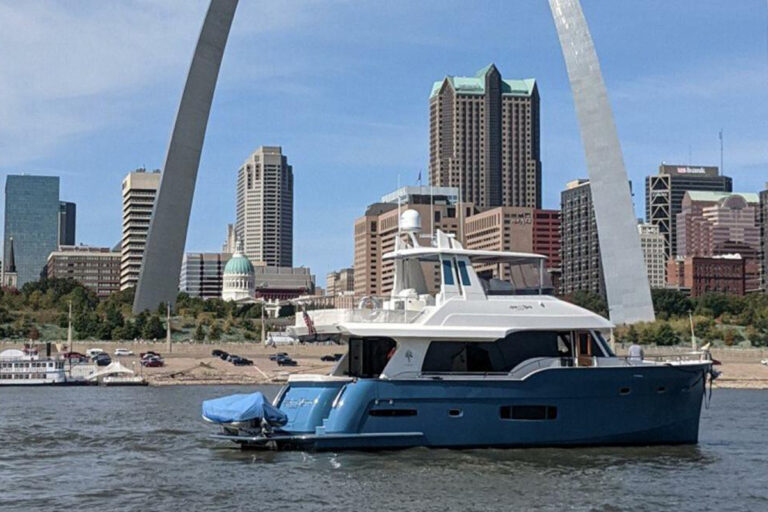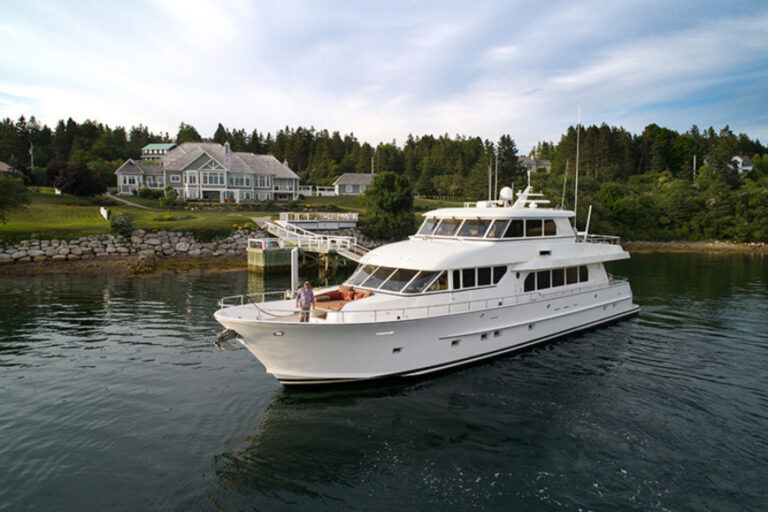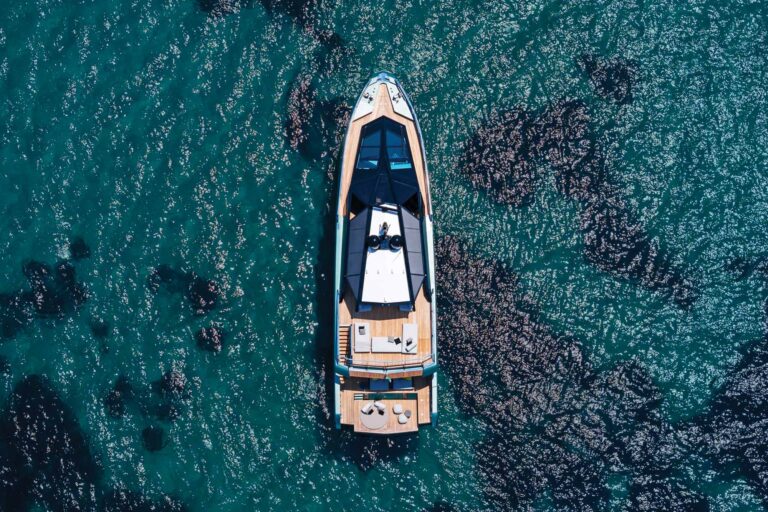The goal of full-beam deckhouse designs is to provide cruising comfort by maximizing interior volume. The trick is achieving this without sacrificing exterior deck space or compromising styling and performance. It’s an art form as much as a science, one that Silverton has mastered with its innovative Sport Bridge designs-and one in which the new 38 stands as the latest of a successful line.
In my estimation, one major source of the popularity of the Sport Bridge concept stems from Silverton’s solution to the most challenging aspect of full-beam arrangements-that is, how to move from stem to stern without having to shimmy along a narrow hullside ledge. Silverton’s SideWalk design is the logical answer for a boat this size. Molded-in steps lead from the aft cockpit to the bridge and a bridge-level side deck-or “SideWalk”-leads forward to the bow. The result is a more pleasurable boating experience, as cruising couples are able to work together when casting off or collecting docklines. It is also easier for the skipper to keep track of young ones on deck.
Armed with the SideWalk solution, Silverton’s next challenge was to package the 38’s full-bodied features in a stylish exterior envelope. Given that the Sport Bridge concept was a step beyond mainstream convention, Silverton’s designers were not obliged to adhere to the status quo. Although Silverton hints at the design’s Euro-styling, I believe credit is due to the builder’s own homegrown ingenuity-and design team. They have done an excellent job of creating a “modern” product designed to please American yachtsmen as well as a wider international audience.
The 38’s large windows and hullside accents all work together to complement her rakish appearance, negating the tendency for such designs to look bloated. Instead, her slight reverse sheer leads the eye to believe that she is longer than her length overall suggests. The one feature that I will concede is ÒEuroÓ is her transom platform design, a portion of which wraps around and stands proud of her hullside. While this look is popular where stern-to mooring is common, i.e., Europe, Americans will have to take care around pilings. Silverton has thoughtfully incorporated a stainless steel chafing guard with this in mind.
But it is the 38’s innovative exterior deck layout and interior arrangement that set her apart. Her bridge control station is forward and has helm and companion seating. A seating area aft has a wet bar that can be fitted with an optional refrigerator. Below, the cockpit is large enough for a table and chairs and has a spot for an ice maker. Optional canvas/Strataglass enclosures are available for both the bridge and the cockpit. The foredeck is for sun worshipers and is fitted with a sunpad. Those who intend to swing on the hook will want the optional Maxwell anchor windlass; specify the full-chain rode if you are serious about spending time anchoring out.
A curved sliding glass door leads from the cockpit to the main cabin. A settee to starboard converts to a full-size berth and is positioned to take advantage of an entertainment center with a 20-inch flat-panel TV. A raised dinette area, an arm’s length from the galley, can seat four comfortably. A two-burner cook-top, a microwave-convection oven and a dual voltage refrigerator/freezer are standard. (Those who opt for the lower control station, an option designed with the northwest U.S. and international markets in mind, will sacrifice the dinette.) The forward stateroom has a queen-island berth. A mid-stateroom with two single berths tucks under the main cabin, where a filler section can be installed to create a full-size berth. The split head and shower compartments have dual access.
Also well worthy of note are the 38’s interior outfitting and fit and finish. Innerspring mattresses, hardwood soles and designer fabrics feel good to the touch. Cherry cabinetwork, cedar-lined lockers and Corian countertops please the eye.
The 38’s hull and superstructure are built with a combination of mat and woven roving. The solid fiberglass bottom is supported by a network of stringers and web frames that are laminated by hand over plywood forms. Plywood structural bulkheads are fiberglassed to the hull. The hull-deck joint is bonded, mechanically fastened and fiberglassed from the inside where accessible. Exterior decks and portions of the superstructure are cored with balsa; many smaller parts are created using a resin transfer system. A barrier coat of vinylester resin in the hull laminate reduces the chance of blistering and the 38 is coated with bottom paint and water-tested before it is shipped from Silverton’s Millville, New Jersey, facility.
The machinery space is reached through a hatch in the cabin sole, although a portion of the sole can be removed for complete access if necessary. Serviceable items appear accessible; exposed areas of the bilge are finished with gelcoat. Engines are mounted on vinyl-coated steel beams that are in turn through-bolted to hearty fiberglass/plywood web frames. A 10 kW generator in a sound shield is positioned in the lazarette with access from the cockpit. An oil X-Change-R system and a Glendinning Cablemaster are desirable options.
Donald L. Blount & Associates has been assisting Silverton with its hull designs for the last few years. The goal has been to craft hull forms with maximum usable interior volume that perform well at speeds in the 25-30 knot range. Blount’s design team was responsible for the 38’s shape from her chine down and for estimating her weight and center of gravity. She has a moderate entry with spray-control rails forward and an efficient 12-degree transom deadrise. Approximately 35 percent of the propeller diameter is recessed in pockets, which allows for a draft of just under 3 feet.
Our test boat was powered with a pair of 370 hp Cummins. While a passing cold front whipped up 4- to 6-foot seas and made data collection impractical, I had an excellent opportunity to gain a feel for the 38. I was quite impressed with her performance: stable and predictable in all directions. With the winds and seas out of the northeast, I ran south comfortably at 21 knots. While I eased her back a bit as I turned into the seas, she shouldered through the slop without hesitation. Our progress generated a bit of spray now and again; however, given the conditions and her size I would consider her relatively dry. She is also relatively quiet-I noted 79 dB(A) in her main cabin while running offshore at 2500 rpm.
In fair weather Silverton suggests a top speed of 30 knots is possible with the 370 hp Cummins. In my view this package or the 440 hp Yanmars is the right choice for the 38; Silverton expects the Yanmar package to deliver a few extra knots at cruising speed. Silverton indicates that gas power is still the most popular option for its boats under 39 feet, and the base price of the 38 with gas power is around $300,000. Still, I believe the 38 deserves the investment in diesel power-particularly if your float plan includes the Bahamas. While power-assist steering is offered as an option, it should not be necessary on a boat this size. Given diesel power, I feel the same way about the optional bow thruster. I would opt for the Glendinning synchronizer.
If you are looking for a competitively priced, stylish design suited for family cruising, it’s hard to beat the Sport Bridge layout. Consumers have voted with their checkbooks. Since introducing the “Sport Bridge” design in 1998, Silverton has delivered several hundred between 33 and 41 feet. n
Contact: Silverton Marine Corporation, (856) 825-4117; www.silverton.com.









